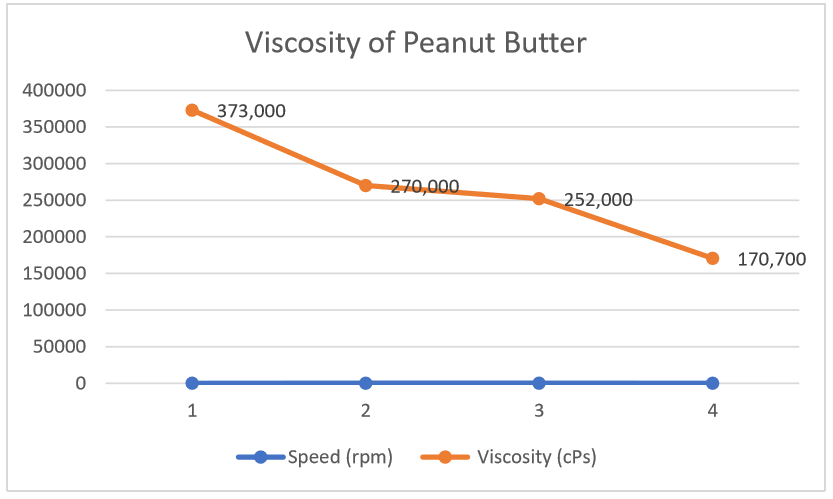Prime Scientific - Viscosity of Peanut Butter Cream
We tested generic peanut butter samples for their viscous properties and in this blog, we share our insights.

i.
ViscoQC 100 Rotational
Viscometer
ii.
RH6 spindle
iii. 600 ml graduated glass beaker

i.
Amount of the sample was
taken that can fill the beaker up to the 500 ml graduation. Care was taken not
to disturb the sample structure while scooping to ensure the sample layers are
uniformly stacked such as not to create any air gaps.
ii.
The RH6 spindle was
inserted into the beaker and the apparatus centered under the viscometer. The
spindle was attached to the viscometer via the magnet coupling and the
instrument confirmed the spindle was inserted by a bleeping sound after which
the spindle data is displayed on the screen.
iii. The sample was tested at different speeds starting at low speeds and then moving up to high speeds. The viscosity reading was taken after 60 sec in each speed
The results obtained are shown in below Table 1, and Chart 1:
Table
1: Results table for viscosity test of peanut butter
|
Speed (rpm) |
Viscosity (cPs) |
Torque% |
|
0.3 |
373,000 |
11.20% |
|
0.6 |
270,000 |
16.20% |
|
2 |
252,000 |
50.40% |
|
4 |
170,700 |
68.30% |
Chart 1: Viscosity vs. Rotational Speed Graph

i.
Peanut butter, as assumed,
displays shear thinning behavior. When the speed in rpm was increased, the
butter viscosity decreased. This corresponds to the case where a consumer will
apply spreading force on a peanut butter to make it an a bread, therefore, the
decrease in viscosity will allow it to be spreadable.
ii.
The measurement range
obtained was 170,000 to 373,000 according to the speed.
iii.
At 50% approx. torque, the
viscosity obtained was 252,000 cPs in a speed of 2 rpm.
iv.
When the speeds were
continued until 12 rpm, the viscometer showed an out of range torque% (above
90%). In order to measure in further speeds, a higher range spindle like RH7
can be used. However, it is not advisable to go for high speed with this type
of samples because the structure will be sheared extensively and will not
recover as shown below.
v.
When speed of 12 rpm was
reached, a measurement was done to a lower speed of 2 rpm and it was found that
the viscosity dropped much lower than the original value of 252,000 cPs at the
same speed. This indicated that the structure of the sample was disturbed and
did not recover its viscous properties.
Prime Scientific
Prime Scientific provides equipment, instruments and other related products and materials. We aim to be a one stop shop for all our customers laboratory needs. Since 2001, Prime has strived to provide the best services and solutions to the scientific community in the region.